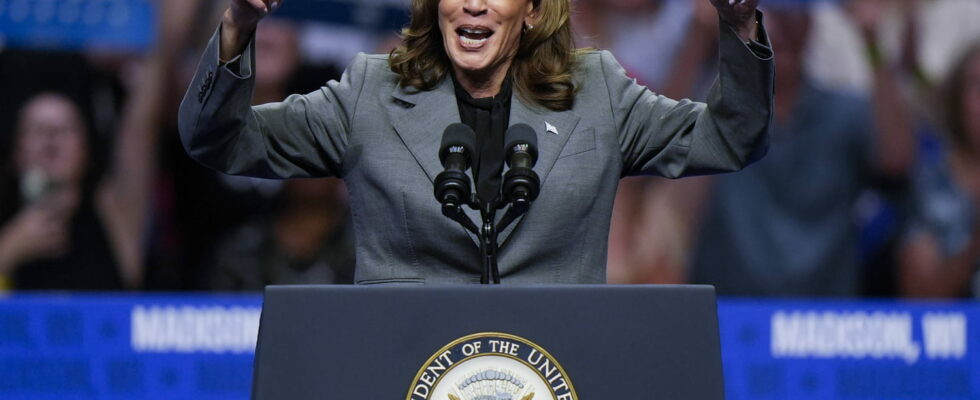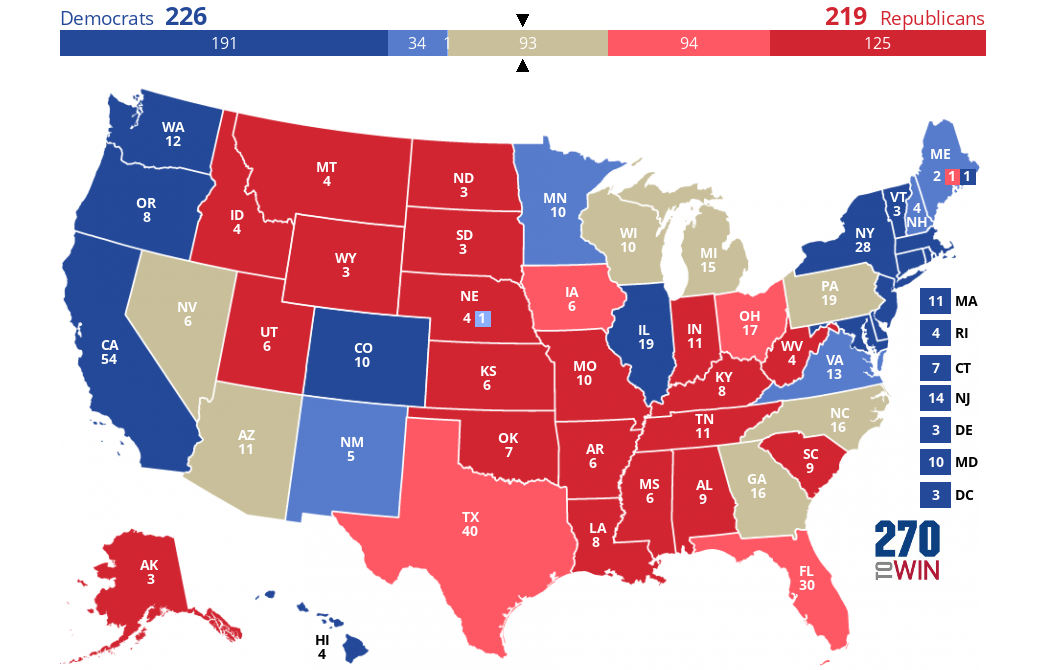With just over a month to go until the presidential election, there are no clouds on the horizon for Kamala Harris’ campaign. The Democrat is neck and neck with Donald Trump in the polls, even widening the gap in some swing states.
An almost perfect campaign for Kamala Harris. The Democratic candidate has been steering her boat perfectly since her official inauguration by her camp, after the withdrawal of Joe BidenThe vice president, who now has the Oval Office of the White House in her sights, has given the Democratic Party some colour in the polls by overtaking her rival. Donald Trump at the national level, but not only. The Democrat’s momentum did not suffer from the debate that pitted Kamala Harris against Donald Trump on September 10, on the contrary. While the Democrat’s qualities as a debater remained to be proven, and left some skeptical, the former prosecutor did not give in to the Republican and his seasoned appearance or aggressive attacks. Moreover, in the general opinion of the American press, she emerged victorious from the duel that could be the only one of the campaign.
If Kamala Harris is definitely well engaged in the presidential campaign and seems able to win the election, anything is still possible less than two months before the election. The trends still have time to reverse, so the Democrat must consolidate her electorate and expand it. Two audiences are targeted in addition to the left: the undecided and the moderate Republicans. Finally, the results of the latest polls in certain Swing states like Arizona or South Carolina are extremely tight, with less than a point difference between the two candidates. Which attests once again to the importance of the result in these relatively divided territories.
Kamala Harris is basing part of her campaign on selected points from her program. The Democratic candidate has made defending purchasing power for the middle classes her hobbyhorse along with abortion rights, always taking care to distinguish herself from Donald Trump’s policy. But several political commentators criticize her for remaining on the surface by citing flagship measures without tackling the substance of certain issues. The vice president, proposing a Democratic program, is also campaigning on points already present in Joe Biden’s campaign, but must seek to stand out, sometimes by appearing more centrist than the American president.
- Defense of purchasing power: While the economy is a central concern for Americans, at a time when inflation continues to be felt and weighs on the employment and housing sectors, Kamala Harris poses as a defender of purchasing power. She assures that she wants to “give money back to middle and working class families” while Donald Trump fights “for billionaires and big business”. And to convince, she cites three strong measures: a tax credit for births, assistance for first-time buyers in housing and a boost for business creation. She also promises to reduce inflation to 3% and control prices for basic necessities and medicines. For the richest, the situation is different since Kamala Harris plans to tax capital gains of households earning more than a million dollars per year at 28%. This is more than the current rate, but less than the 39% desired by Joe Biden.
- Ecological measures : the ecological aspect is not the most substantiated part of Kamala Harris’ program, but the candidate is investing in the subject to stand out from Donald Trump who broke with the Paris agreements during his presidential term. If she defends “the right to breathe clean air, drink clean water and live without the pollution that fuels the climate crisis”, she does not specify how. At the same time, she is doing about-faces on several measures that she defended in the past: no more question of opposing hydraulic fracturing, a technique that allows rocks to be cracked to extract hydrocarbons, no more question of banning plastic straws and other waste of the type that are nevertheless replaceable. Following in the footsteps of Joe Biden, Kamala Harris says she is in favor of the inflation reduction act (IRA), a set of ecological, economic and social measures.
- Migration policy : Immigration is another big issue in the presidential campaign on which Kamala Harris is playing a balancing act. She wants to appear firm to attract the moderate right, but not too closed so as not to scare away the left. However, the candidate has announced a hardening of migration policy involving “consequences” for illegal migrants and investments in physical barriers at the border with Mexico.
- Social measures : Kamala Harris has mainly placed social issues at the heart of her campaign, starting with the right to abortion in the face of a Republican camp at the origin of the tightening of access to IVG in several States. The defense of minorities is also a central point of the campaign.
- International : in terms of foreign policy, Kamala Harris positions herself mainly on Ukraine and the Israeli-Palestinian conflict. On the latter, she reiterated her commitment to defending the Hebrew state and specified that she would not suspend American arms deliveries to Israel in the event of a victory, but she also wants to appear less pro-Israeli than Joe Biden and condemned the violence perpetrated against Palestinian civilians. She declared that “far too many innocent Palestinians have been killed” and called for “a ceasefire”. As for Ukraine, she reaffirmed the United States’ support for the country after the Russian invasion. Moreover, she pinned Donald Trump on his good relations with leaders Vladimir Putin and Kim Jong Un and assured that she would not make “friends” with dictators.
Kamala Harris’ candidacy to replace Joe Biden has put the vice president at the top of voting intentions, while the White House tenant was struggling to assert himself against Donald Trump. According to polls collected by the site 270 to winNationally, Kamala Harris has a 2.9-point lead with 48.8%, compared to Donald Trump’s 45.9% (data as of September 24, 2024).
But the results of the state polls are very close, and these are the ones that count. According to the American voting system, each state won guarantees a certain number of votes out of the 538 electors who vote to elect the American president. Most of the 50 states are won by a political party, but the “swing states” swing to the right or left depending on the polls. The latter, which number seven (Arizona, North Carolina, Georgia, Michigan, Florida, Pennsylvania and Wisconsin), must be won to ensure access to the White House.
Kamala Harris is building a small lead in Michigan, Pennsylvania and Wisconsin, with 2 to 3 points more than her opponent in the polls collected by the site. 270 to win. But Donald Trump is better placed with a 1 to 4 point gap in Florida and Georgia. In the other two (North Carolina and Arizona), it is the Democrat who seems to be in a good position, but the gap, which is less than a point, is still too tight to ensure a victory.
Kamala Harris’ personal journey is impressive and the vice president knows how to remind people of it. “I am the empirical proof of the promise of America,” she regularly explains. African-American, with Jamaican origins on her father’s side and Indian origins on her mother’s, and from an academic background, she became the first woman to be elected prosecutor of San Francisco, before becoming attorney general of California from 2011 to 2017. As a woman, Kamala Harris is likely to obtain a better score than Joe Biden, but especially than Donald Trump, among American female voters. The Democrats historically record good scores with this electorate and hope to capitalize further on these votes with their candidate.
If Kamala Harris is a pure Democrat from California who convinces in historically Democratic states, she may have more difficulty convincing in the Midwestern states that lean towards the Republican side or swing from one camp to the other depending on the polls. To seduce this electorate, her running mate Tim Walz could be a good asset. Governor of Minnesota, the politician is popular in the Midwest to the point that he was appointed instead of Josh Shapiro, another popular Democrat in this region of the United States. The vice-presidential candidate also helps to balance and reassure the male electorate as a white man alongside a female and black candidate.
Born on October 20, 1964 in Oakland, California, to a Jamaican father, an economics professor at Stanford University, and an Indian mother, an oncologist by profession, Kamala Harris began by obtaining her bachelor’s degree in the United States before obtaining a degree in political science from Howard University in Washington, then a second law degree in Hastings, California. Married since 2014 to lawyer Douglas Emhoff, Kamala Harris has two children from a first marriage: Cole and Ella.
In 1990, she joined the California bar and started as an assistant district attorney for Alameda County before being elected district attorney for the San Francisco district from 2004 to 2011. She was the first woman to hold this position in the United States, before becoming California’s attorney general from 2010 to 2017. January 3, 2017 marked a turning point in Kamala Harris’ political career, when she was elected as senator for California to replace Barbara Boxer. She then became the second black senator in the United States. A mandate she would hold until 2021. During these years, she campaigned against racial discrimination, Donald Trump’s immigration policy and supported the Black Lives Matter movement after the death of George Floyd.
In the meantime, Kamala Harris is a candidate for the 2020 presidential nomination, but ultimately withdraws before the official start of the primaries. Joe Biden chooses her as his running mate and Democratic candidate for vice president. The duo wins and accedes to the presidency of the country in 2020 by defeating Donald Trump. Kamala Harris also becomes the first African and Asian-American person to hold such a position. In August 2024, she becomes the Democratic Party’s candidate for the presidential election in November, after Joe Biden withdraws from the race for the White House. She therefore faces Donald Trump, in an attempt to run for a first term as President of the United States.

